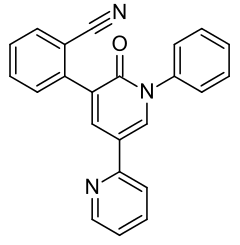Perampanel
 | |
| Systematic (IUPAC) name | |
|---|---|
| 5'-(2-cyanophenyl)-1'-phenyl-2,3'-bipyridinyl-6'(1'H)-one | |
| Clinical data | |
| Trade names | Fycompa |
| Licence data | EMA:Link, US FDA:link |
| |
| |
| Pharmacokinetic data | |
| Bioavailability | 116%[1] |
| Protein binding | 95–96% |
| Metabolism | hepatic, mostly via CYP3A4 and/or CYP3A5 |
| Half-life | 105 hrs, 295 hrs (moderate hepatic impairment) |
| Excretion | 70% faeces, 30% urine |
| Identifiers | |
|
380917-97-5 | |
| N03AX22 | |
| PubChem | CID 9924495 |
| ChemSpider |
8100130 |
| UNII |
H821664NPK |
| KEGG |
D08964 |
| ChEBI |
CHEBI:71013 |
| ChEMBL |
CHEMBL1214124 |
| Synonyms | E2007 |
| Chemical data | |
| Formula | C23H15N3O |
| 349.384 g/mol | |
|
SMILES
| |
| |
| | |
Perampanel (INN/USAN, trade name Fycompa) is an antiepileptic drug developed by Eisai Co. that acts as a selective non-competitive antagonist of AMPA receptors, the major subtype of ionotropic glutamate receptors.[2][3]
Perampanel was found to be effective in the treatment of refractory partial-onset seizures in three pivotal (Phase 3) clinical trials[4][4][5] and has been approved for marketing under the brand name Fycompa by the European Medicines Agency.[6] The minimum effective dose is 4 mg once daily; doses of 8 mg and 12 mg daily provide a greater therapeutic benefit with a corresponding increase in adverse events. Dizziness and somnolence/sedation/fatigue are the most frequent dose-related adverse events. The drug is currently approved, for the control of partial-onset seizures, in those of both sexes who suffer from epilepsy and who are 12 years of age and older, by the Food and Drug Administration. Perampanel is also approved for the treatment of primary generalized tonic-clonic seizures in patients with epilepsy aged 12 years and older. It is designated as a Schedule III controlled substance by the Drug Enforcement Administration. Perampanel has been studied in other clinical indications including Parkinson's disease.[7][8]
Mechanism of Action
Whole-cell voltage clamp studies have demonstrated that perampanel is a negative allosteric AMPA receptor antagonist.[9] Perampanel caused a slow (τ∼1 s at 3 µM), concentration-dependent inhibition of AMPA receptor currents. The rates of block and unblock of AMPA receptor currents were 1.5 × 105 M−1 s−1 and 0.58 s−1, respectively. Perampanel did not affect NMDA receptor currents. The extent of block (IC50, 0.56 µM) was similar at all agonist concentrations, demonstrating a noncompetitive blocking action. Parampanel did affect AMPA receptor desensitization, or the ratio of peak to late response to rapid application of AMPA.[9] Perampanel is a selective negative allosteric AMPA receptor antagonist of high-affinity and slow blocking kinetics, and is not use-dependent.
Pharmacokinetics
Perampanel has a prolonged terminal half-life in humans of approximately 105 hours. The drug is 95% bound to plasma protein. Its primary route of metabolism is by CYP3A4. It does not induce P450 enzymes. About 70% of the dose is excreted in the feces and 30% in the urine; less than 2% of the dose is excreted unchanged into the urine.
Side effects
In clinical trials, perampanel was generally well tolerated although the incidence of adverse events increased in a dose-dependent fashion. There was no increase in serious adverse events compared with placebo. According to the Food and Drug Administration, most common adverse reactions reported by patients receiving Fycompa in clinical trials include dizziness, drowsiness, fatigue, irritability, falls, upper respiratory tract infection, weight increase, vertigo, loss of muscle coordination (ataxia), gait disturbance, balance disorder, anxiety, blurred vision, stuttering (dysarthria), weakness (asthenia), aggression, and excessive sleep (hypersomnia).[10]
Fycompa’s label has a boxed warning to alert prescribers and patients about the risk of serious neuropsychiatric events. Some of these events were reported as serious and life-threatening. Violent thoughts or threatening behavior (including homicidal ideation) was also observed in a few patients. Patients and caregivers should alert a health care professional immediately if changes in mood or behavior that are not typical for the patient are observed. Health care professionals should closely monitor patients during the titration period when higher doses are used.[10]
See also
References
- ↑ Yang, X; Wu T-C; Yuxin Men A; Lee J-Y; Bhattaram VA; Mehta MU. "U.S. FDA Clinical Pharmacology Review. Fycompa™ (perampanel)" (PDF). p. 25.
- ↑ Rogawski, M. A. (2011). "Revisiting AMPA Receptors as an Antiepileptic Drug Target". Epilepsy Currents 11 (2): 56–63. doi:10.5698/1535-7511-11.2.56. PMC 3117497. PMID 21686307.
- ↑ Rogawski MA, Hanada T. Preclinical pharmacology of perampanel, a selective non-competitive AMPA receptor antagonist. Acta Neurol Scand 2013;127 (Suppl. 197): 19–24.
- ↑ 4.0 4.1 French, J. A.; Krauss, G. L.; Biton, V.; Squillacote, D.; Yang, H.; Laurenza, A.; Kumar, D.; Rogawski, M. A.; Campanille, V.; Floridia, J.; Ilari, R.; Consalvo, D. E.; Thomson, A.; Sfaello, I.; Pociecha, J.; Nieto, F.; Firstenfeld, A.; Zuin, D.; Mesri, J.; Silva, W.; Nofal, P.; Cristalli, D.; Clement, J. F.; Hwang, P.; McLachlan, R.; Pillay, N.; Lasso, J.; Peralta, B. L.; Hernandez, M. L.; Tenhamm, E. (2012). "Adjunctive perampanel for refractory partial-onset seizures: Randomized phase III study 304". Neurology 79 (6): 589–596. doi:10.1212/WNL.0b013e3182635735. PMC 3413761. PMID 22843280.
- ↑ Krauss, G. L.; Serratosa, J. M.; Villanueva, V.; Endziniene, M.; Hong, Z.; French, J.; Yang, H.; Squillacote, D.; Edwards, H. B.; Zhu, J.; Laurenza, A. (2012). "Randomized phase III study 306: Adjunctive perampanel for refractory partial-onset seizures". Neurology 78 (18): 1408–1415. doi:10.1212/WNL.0b013e318254473a. PMID 22517103.
- ↑ "European Medicines Agency Report on Perampanel".
- ↑ Gottwald MD, Aminoff MJ (July 2008). "New frontiers in the pharmacological management of Parkinson's disease". Drugs Today 44 (7): 531–45. doi:10.1358/dot.2008.44.7.1217105. PMID 18806903.
- ↑ http://www.webmd.com/epilepsy/news/20121024/epilepsy-drug-fycompa-approved
- ↑ 9.0 9.1 Chen CY, Matt L, Hell JW, Rogawski MA (Sep 17, 2014). "Perampanel inhibition of AMPA receptor currents in cultured hippocampal neurons". PLoS One 9 (9): e108021. doi:10.1371/journal.pone.0108021. PMID 25229608.
- ↑ 10.0 10.1 http://www.fda.gov/NewsEvents/Newsroom/PressAnnouncements/ucm325038.htm
| ||||||||||||||||||||||||||||||||||||||||||||||||||||||||||||||||||||||||||||||||||||||||||||